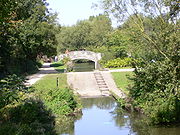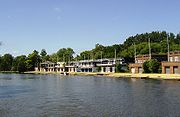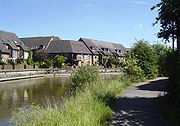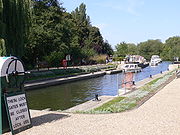
Iffley Lock
Encyclopedia
Iffley Lock is a lock
on the River Thames
in England near the village of Iffley
, Oxfordshire
. It is on the southern outskirts of Oxford
. The original lock was built by the Oxford-Burcot Commission
in 1631 and the Thames Navigation Commission
replaced this in 1793. The lock has a set of rollers to allow punts
and rowing boats to be moved between the water levels.
In addition the lock and weir streams there is stream further to the east which used to be the Mill Stream.
The weir is downstream of the lock, where the weir stream is joined by the mill stream.
 A weir was owned by Lincoln College
A weir was owned by Lincoln College
as early as 1302 and this weir may have carried the bridge which is referenced earlier than this. Iffley Lock was the pound lock furthest upstream that was built by the Oxford-Burcot Commission in 1631. In 1790 the Thames Commissioners took over Iffley and the other Oxford-Burcot locks at Sandford
and Swift Ditch
. The Commission rebuilt the lock in 1793, and the keeper was instructed to take tolls for "punt
s, pleasure boats, skiff
s and wherries
" at a charge of sixpence for punts and skiffs and one shilling for four oared craft. However access to the lock was awkward for barge traffic heading for the Thames and Severn Canal
which had to enter backwards and take down their masts. Improvements and enlargements were made to the lock in 1802 and 1806 and the stone lockhouse was built in 1810. In 1826, it was ordered that no craft should pass through the lock during the hours of divine service. In the middle of the 19th century there was a problem with water levels below the water and a witness to a parliamentary enquiry reported that cows and horses were sometimes driven into the river to create sufficient draught. The lock was repaired in 1866, and ten years later the lock was being blamed for flooding in Oxford. Although the boat slide was promised in 1885, at the same time the Thames Conservancy were considering removing the lock. However there were many petitions to retain it and it survived. The latest rebuilding took place in 1927.

 The river at this point and around Oxford in general is sometimes known as the Isis
The river at this point and around Oxford in general is sometimes known as the Isis
. Donnington Bridge
crosses the river upstream of the lock and then the River Cherwell
joins the Thames on the northern side. The university college boathouses line the bank on the northern side, followed by Christ Church Meadow. This upstream stretch of the river is used for rowing
, and is the location of the University rowing regattas of Torpids
and Summer Eights
. After Christchurch Meadow is Folly Bridge
where are the landing stages for pleasure boats. After Folly Bridge, the river runs through suburbs where it is crossed by Grandpont Bridge. Beyond this is the Gasworks Bridge, a converted railway bridge, and the Osney Rail Bridge
.
The Thames Path
stays on the western side towards South Hinksey
until it reaches Osney Lock.


Lock (water transport)
A lock is a device for raising and lowering boats between stretches of water of different levels on river and canal waterways. The distinguishing feature of a lock is a fixed chamber in which the water level can be varied; whereas in a caisson lock, a boat lift, or on a canal inclined plane, it is...
on the River Thames
River Thames
The River Thames flows through southern England. It is the longest river entirely in England and the second longest in the United Kingdom. While it is best known because its lower reaches flow through central London, the river flows alongside several other towns and cities, including Oxford,...
in England near the village of Iffley
Iffley
Iffley is a village in Oxfordshire, England, within the boundaries of the city of Oxford, between Cowley and the estates of Rose Hill and Donnington, and in proximity to the River Thames . Its most notable feature is its original and largely unchanged Norman church, St Mary the Virgin, which has a...
, Oxfordshire
Oxfordshire
Oxfordshire is a county in the South East region of England, bordering on Warwickshire and Northamptonshire , Buckinghamshire , Berkshire , Wiltshire and Gloucestershire ....
. It is on the southern outskirts of Oxford
Oxford
The city of Oxford is the county town of Oxfordshire, England. The city, made prominent by its medieval university, has a population of just under 165,000, with 153,900 living within the district boundary. It lies about 50 miles north-west of London. The rivers Cherwell and Thames run through...
. The original lock was built by the Oxford-Burcot Commission
Oxford-Burcot Commission
The Oxford-Burcot Commission was the first Commission concerned with the management of the River Thames, appointed by an Act of Parliament of 1605 by James I to make the stretch of river from Burcot to Oxford navigable. The Commission took responsibility for the management of the River Thames...
in 1631 and the Thames Navigation Commission
Thames Navigation Commission
The Thames Navigation Commission used to manage the River Thames in southern England. In particular, they were responsible for installing or renovating many of the locks on the river in the 18th and early 19th centuries.- History :...
replaced this in 1793. The lock has a set of rollers to allow punts
Punt (boat)
A punt is a flat-bottomed boat with a square-cut bow, designed for use in small rivers or other shallow water. Punting refers to boating in a punt. The punter generally propels the punt by pushing against the river bed with a pole...
and rowing boats to be moved between the water levels.
In addition the lock and weir streams there is stream further to the east which used to be the Mill Stream.
The weir is downstream of the lock, where the weir stream is joined by the mill stream.
History

Lincoln College, Oxford
Lincoln College is one of the constituent colleges of the University of Oxford in the United Kingdom. It is situated on Turl Street in central Oxford, backing onto Brasenose College and adjacent to Exeter College...
as early as 1302 and this weir may have carried the bridge which is referenced earlier than this. Iffley Lock was the pound lock furthest upstream that was built by the Oxford-Burcot Commission in 1631. In 1790 the Thames Commissioners took over Iffley and the other Oxford-Burcot locks at Sandford
Sandford Lock
Sandford Lock is a lock on the River Thames in England, situated at Sandford-on-Thames which is just South of Oxford. The first pound lock was built in 1631 by the Oxford-Burcot Commission although this has since been rebuilt...
and Swift Ditch
Swift Ditch
The Swift Ditch is a backwater of the River Thames in England, which was formerly the primary navigation channel. With the main river, it creates the large island of Andersey Island near Abingdon, Oxfordshire....
. The Commission rebuilt the lock in 1793, and the keeper was instructed to take tolls for "punt
Punt (boat)
A punt is a flat-bottomed boat with a square-cut bow, designed for use in small rivers or other shallow water. Punting refers to boating in a punt. The punter generally propels the punt by pushing against the river bed with a pole...
s, pleasure boats, skiff
Thames skiff
A Thames skiff is a traditional River Thames wooden rowing boat used for the activity of Skiffing. These boats evolved from Thames wherries in the Victorian era to meet a passion for river exploration and leisure outings on the water.-Construction of a skiff:...
s and wherries
Wherry
A wherry is a type of boat that was traditionally used for carrying cargo or passengers on rivers and canals in England, and is particularly associated with the River Thames and also with the Broadland rivers of Norfolk and Suffolk. London passenger wherries evolved into the Thames skiff, a...
" at a charge of sixpence for punts and skiffs and one shilling for four oared craft. However access to the lock was awkward for barge traffic heading for the Thames and Severn Canal
Thames and Severn Canal
The Thames and Severn Canal is a canal in Gloucestershire in the south of England, which was completed in 1789. It was conceived as part of a canal route from Bristol to London. At its eastern end, it connects to the River Thames at Inglesham Lock near Lechlade, while at its western end, it...
which had to enter backwards and take down their masts. Improvements and enlargements were made to the lock in 1802 and 1806 and the stone lockhouse was built in 1810. In 1826, it was ordered that no craft should pass through the lock during the hours of divine service. In the middle of the 19th century there was a problem with water levels below the water and a witness to a parliamentary enquiry reported that cows and horses were sometimes driven into the river to create sufficient draught. The lock was repaired in 1866, and ten years later the lock was being blamed for flooding in Oxford. Although the boat slide was promised in 1885, at the same time the Thames Conservancy were considering removing the lock. However there were many petitions to retain it and it survived. The latest rebuilding took place in 1927.
Access to the lock
The lock can be reached on foot on the track from Donnington Bridge on the western side.Reach above the lock


The Isis
The Isis is the name given to the part of the River Thames above Iffley Lock which flows through the city of Oxford. The name is especially used in the context of rowing at the University of Oxford...
. Donnington Bridge
Donnington Bridge
Donnington Bridge is a modern road bridge over the River Thames, in the south of the city of Oxford, England. At this point the river is sometimes called the Isis. The bridge carries the B4495 road from Abingdon Road to Iffley Road...
crosses the river upstream of the lock and then the River Cherwell
River Cherwell
The River Cherwell is a river which flows through the Midlands of England. It is a major tributary of the River Thames.The general course of the River Cherwell is north to south and the 'straight-line' distance from its source to the Thames is about...
joins the Thames on the northern side. The university college boathouses line the bank on the northern side, followed by Christ Church Meadow. This upstream stretch of the river is used for rowing
Sport rowing
Rowing is a sport in which athletes race against each other on rivers, on lakes or on the ocean, depending upon the type of race and the discipline. The boats are propelled by the reaction forces on the oar blades as they are pushed against the water...
, and is the location of the University rowing regattas of Torpids
Torpids
Torpids is one of two series of bumping races held yearly at Oxford University, the other being Eights. Over 130 men's and women's crews race for their colleges in six men's divisions and five women's; almost 1200 participants in total...
and Summer Eights
Eights Week
Eights Week, also known as Summer Eights, is a four-day regatta of bumps races which constitutes the University of Oxford's main intercollegiate rowing event of the year. The regatta takes place in May of each year, from the Wednesday to the Saturday of the fifth week of Trinity term...
. After Christchurch Meadow is Folly Bridge
Folly Bridge
Folly Bridge is a stone bridge over the River Thames carrying the Abingdon Road, south from the centre of Oxford, England. It was erected 1825–27, to designs of a little-known architect, Ebenezer Perry , who practiced in London....
where are the landing stages for pleasure boats. After Folly Bridge, the river runs through suburbs where it is crossed by Grandpont Bridge. Beyond this is the Gasworks Bridge, a converted railway bridge, and the Osney Rail Bridge
Osney Rail Bridge
Osney Rail Bridge is a railway bridge over the River Thames at Oxford in England. It carries the Cherwell Valley Line between Didcot and Oxford across the river on the reach between Iffley Lock and Osney Lock....
.
The Thames Path
Thames Path
The Thames Path is a National Trail, opened in 1996, following the length of the River Thames from its source near Kemble in Gloucestershire to the Thames Barrier at Charlton. It is about long....
stays on the western side towards South Hinksey
South Hinksey
South Hinksey is a village and civil parish just over south of the centre of Oxford. The parish includes the residential area of Hinksey Hill about south of the village....
until it reaches Osney Lock.
See also


- Locks on the River ThamesLocks on the River ThamesThe English River Thames is navigable from Cricklade or Lechlade to the sea, and this part of the river falls 71 metres . There are 45 locks on the river, each with one or more adjacent weirs...
- Rowing on the River ThamesRowing on the River ThamesThe River Thames is one of the main rowing areas in England, with activity taking place on the Tideway and on the 45 separate lock reaches on the non tidal section. The river hosts two major rowing events The Boat Race and Henley Royal Regatta, and a large number of other regattas and long distance...

